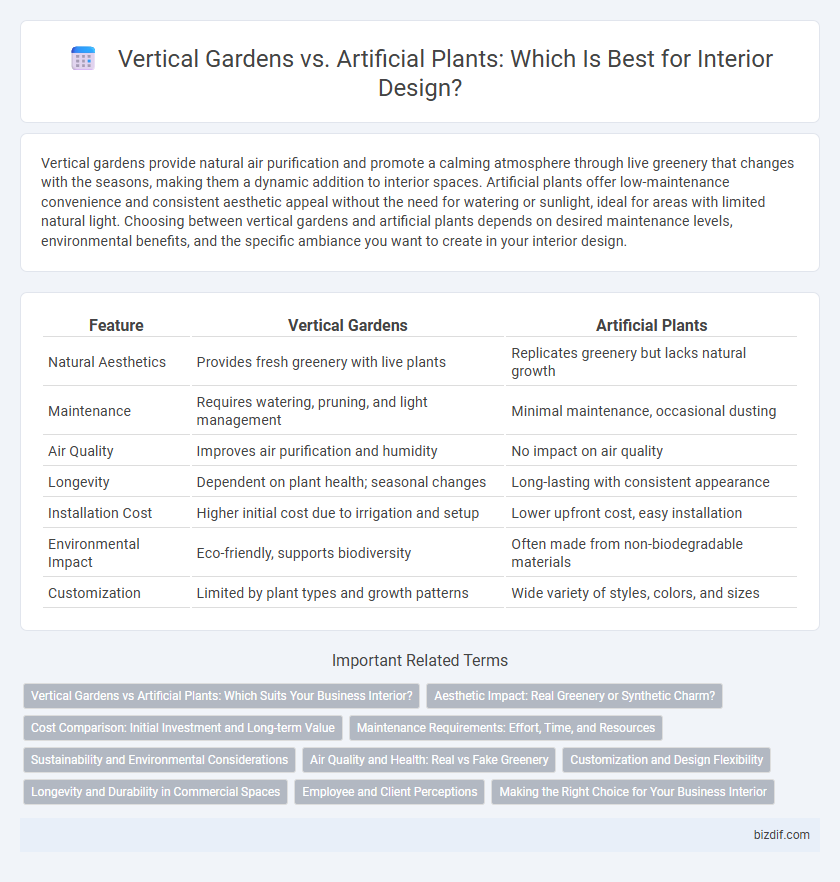Vertical gardens provide natural air purification and promote a calming atmosphere through live greenery that changes with the seasons, making them a dynamic addition to interior spaces. Artificial plants offer low-maintenance convenience and consistent aesthetic appeal without the need for watering or sunlight, ideal for areas with limited natural light. Choosing between vertical gardens and artificial plants depends on desired maintenance levels, environmental benefits, and the specific ambiance you want to create in your interior design.
Table of Comparison
| Feature | Vertical Gardens | Artificial Plants |
|---|---|---|
| Natural Aesthetics | Provides fresh greenery with live plants | Replicates greenery but lacks natural growth |
| Maintenance | Requires watering, pruning, and light management | Minimal maintenance, occasional dusting |
| Air Quality | Improves air purification and humidity | No impact on air quality |
| Longevity | Dependent on plant health; seasonal changes | Long-lasting with consistent appearance |
| Installation Cost | Higher initial cost due to irrigation and setup | Lower upfront cost, easy installation |
| Environmental Impact | Eco-friendly, supports biodiversity | Often made from non-biodegradable materials |
| Customization | Limited by plant types and growth patterns | Wide variety of styles, colors, and sizes |
Vertical Gardens vs Artificial Plants: Which Suits Your Business Interior?
Vertical gardens enhance business interiors by improving air quality, boosting employee well-being, and creating a natural aesthetic that promotes sustainability. Artificial plants offer low-maintenance greenery with consistent appearance but lack the environmental benefits and air purification properties of living plants. Choosing vertical gardens supports eco-friendly branding and fosters a healthier workspace, whereas artificial plants provide convenient decor solutions in spaces with limited natural light or care resources.
Aesthetic Impact: Real Greenery or Synthetic Charm?
Vertical gardens offer authentic greenery that enhances indoor air quality and introduces a dynamic, living element to interior spaces, creating a vibrant focal point. Artificial plants provide consistent aesthetic appeal with minimal upkeep, ideal for low-light or maintenance-challenged environments while maintaining decorative value. The choice between vertical gardens and artificial plants hinges on balancing the desire for natural ambiance against practicality and longevity in interior design.
Cost Comparison: Initial Investment and Long-term Value
Vertical gardens require a higher initial investment due to the costs of plants, soil, irrigation systems, and structural support, but they offer long-term value through air purification and natural aesthetics. Artificial plants have a lower upfront cost and minimal maintenance expenses, making them budget-friendly initially but lacking benefits like improved indoor air quality. Over time, vertical gardens provide better returns on investment by enhancing well-being and property value, while artificial plants may need replacement to maintain appearance.
Maintenance Requirements: Effort, Time, and Resources
Vertical gardens demand consistent maintenance involving regular watering, pruning, and nutrient management to ensure plant health and growth, often requiring more time and specialized knowledge. Artificial plants require minimal upkeep, limited to occasional dusting and cleaning, significantly reducing time and effort compared to living greenery. Resource-wise, vertical gardens consume water and fertilizers, while artificial plants, although low-maintenance, may have environmental costs associated with their manufacturing materials.
Sustainability and Environmental Considerations
Vertical gardens contribute to sustainability by improving air quality, reducing urban heat, and supporting biodiversity through natural plant growth. Artificial plants, while low-maintenance and allergen-free, lack the environmental benefits and often involve non-biodegradable materials with a higher carbon footprint. Choosing vertical gardens enhances eco-friendly interior design by integrating renewable, natural elements that promote a healthier indoor environment.
Air Quality and Health: Real vs Fake Greenery
Vertical gardens with real plants significantly improve indoor air quality by absorbing carbon dioxide and releasing oxygen, while also filtering harmful pollutants and toxins. Artificial plants lack these natural air-purifying properties and may even accumulate dust, potentially affecting respiratory health. Integrating live vertical gardens promotes better indoor health and enhances overall air freshness compared to fake greenery.
Customization and Design Flexibility
Vertical gardens offer unparalleled customization by allowing designers to select a variety of live plants tailored to specific light, humidity, and aesthetic preferences, creating dynamic and evolving interior landscapes. Artificial plants provide greater design flexibility, requiring minimal maintenance and enabling consistent color, size, and shape across diverse indoor environments without dependency on natural conditions. Choosing between vertical gardens and artificial plants depends on the desired balance between organic vitality and effortless adaptability in interior design projects.
Longevity and Durability in Commercial Spaces
Vertical gardens offer natural air purification and evolve aesthetically over time but require regular maintenance to ensure longevity in commercial spaces. Artificial plants provide consistent durability with minimal upkeep, maintaining their appearance regardless of environmental conditions. Choosing between the two depends on balancing the desire for natural ambiance with the need for long-term resilience and low maintenance.
Employee and Client Perceptions
Vertical gardens enhance office environments by improving air quality and providing natural greenery, which boosts employee well-being and creates a positive impression on clients. Artificial plants offer low-maintenance decor but often lack the authenticity and health benefits that contribute to higher employee satisfaction and perceived office value. Studies show that workplaces with living plants, such as vertical gardens, tend to report increased productivity and stronger client trust compared to spaces featuring only artificial greenery.
Making the Right Choice for Your Business Interior
Vertical gardens offer natural air purification and a dynamic aesthetic that can enhance employee well-being and customer appeal, making them ideal for businesses prioritizing sustainability and health. Artificial plants provide low-maintenance, allergen-free greenery with consistent appearance, suitable for busy environments or spaces with limited natural light. Choosing between vertical gardens and artificial plants depends on factors like maintenance capacity, budget, lighting conditions, and desired environmental impact.
Vertical gardens vs Artificial plants Infographic

 bizdif.com
bizdif.com